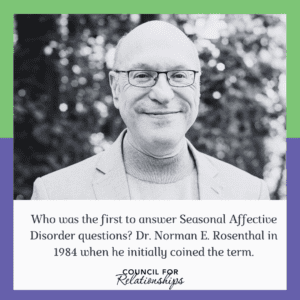Seasonal Affective Disorder Questions Answered!
Do you find that the winter months are, at best, icy for your mental health? Or perhaps instead of being excited to go to the beach, the start of summer puts you in a sunburnt mood? Maybe you are experiencing Seasonal Affective Disorder (SAD). You can find what seems like endless information about SAD on the internet, but there are some Seasonal Affective Disorder questions not adequately answered.
So, we asked Dr. Becky Wu, a psychiatrist on our staff, to answer those questions. Questions like the following:
- What does the Diagnostic Manual of Mental Disorders (DSM-5) say about Seasonal Affective Disorder?
- What are the risk factors for Seasonal Affective Disorder, and what are the symptoms?
- Is SAD treatable?
- What is light therapy, and what are the best lights for Seasonal Affective Disorder?
- Can Vitamin D help with Seasonal Affective Disorder?
- Can antidepressants treat Seasonal Affective Disorder?
 Common Questions about Seasonal Affective Disorder
Common Questions about Seasonal Affective Disorder
As seasons change with colder weather, less sun exposure, and longer nights, it is not uncommon for our moods to change as well. Some refer to this mood dip as the “winter blues.” If you feel consistently down and it affects your daily life, you might have Seasonal Affective Disorder (SAD).
What does the Diagnostic Manual of Mental Disorders (DSM-5) say about Seasonal Affective Disorder?
SAD is when mood symptoms come back at the same time each year for at least two years. It starts at the beginning of a season and goes away by the next season.
SAD can cause mood changes, like depression, mania, or hypomania, that happen at certain times of the year.
Hypomania is a state where one exhibits heightened energy, activity levels, mood, or behavior. This newfound “charged-up” version of oneself is noticeable to others as different from their typical self. People often associate hypomania with bipolar disorder, as it represents a milder version of mania. Approaches to managing hypomania include therapy, medication, and self-care techniques.
If you are not in the mental health field, you may be wondering what the DSM-5 actually is. The DSM-5 is a manual used by mental health professionals in the United States to classify mental disorders.
What are the risk factors for Seasonal Affective Disorder, and what are the symptoms?
SAD affects 5% of the general population and 10-20% of people with a history of major depression. Some studies have suggested that the following are those two potential risk factors for developing SAD:
- Being a female
- Living at higher latitudes
Because many do not have the DSM-5 handy, the following are signs of depression:
- Feeling sad
- Being unable to feel happy
- Having difficulty with eating, sleeping, or focusing
- Having thoughts of suicide
People with SAD in winter may experience additional symptoms alongside the typical signs of depression. These symptoms include increased sleep, a strong craving for carbohydrates, and potential weight gain.
Is SAD treatable?
If you or a loved one is experiencing any of the above symptoms, the good news is treatment is available!
You should contact a healthcare professional such as a therapist, psychiatrist, or primary care provider. They can discuss different treatment options with you, such as bright light therapy, medications, or psychotherapy. By the way, people often refer to psychotherapy as “talk therapy.”
If you or someone you know is feeling extremely sad or considering suicide, please take immediate action. You can call 911, contact the national suicide hotline at 988, or go directly to the nearest emergency room.
What is light therapy, and what are the best lights for Seasonal Affective Disorder?
Light therapy, also known as “light boxes,” acts like the sunlight you get outdoors. This light can change your brain and make you happier. It also helps with SAD symptoms like tiredness and excessive sleep.
It involves using a powerful light for 30 minutes daily. Typically, people do this in the morning at a consistent time.
For the best lights for Seasonal Affective Disorder, ensure they have an intensity of 10,000 lux. However, the United States Food and Drug Administration (FDA) does not regulate light boxes for SAD treatment.
Can Vitamin D help with Seasonal Affective Disorder?
Supplementing Vitamin D may be helpful, but research shows mixed results on its effectiveness.
Can antidepressants treat Seasonal Affective Disorder?
Antidepressants such as bupropion are the first-line medication, but other antidepressants may also be helpful. Antidepressants are prescription medicines to treat depression.
About the Author
Becky Wu, MD, is a Philadelphia psychiatrist accepting new individual, couples, and family clients online and in person. You can contact her with any Seasonal Affective Disorder questions or about Dr. Wu’s practice. You can do this by completing the form on her Clinician Biography page. Click here to request an appointment with a CFR clinician.
See our Therapist & Psychiatrist Directory to find a different CFR therapist or psychiatrist near you.
More from CFR
CFR has so much more for you to explore from our expert therapists, psychologists, and psychiatrists. Check out the CFR Expert Voices blog for great mental health advice and insight. Here are a few recent blogs we think you will enjoy.

